...a theory on inkjet printers, lettering transfers, and washability...
I wrote this post on the topic of lettering when I was stitching my Breakfast at Tiffany's block.

In that post, I mentioned this class that I had taken with Canby Robertson; a needleartist, teacher and designer who also happens to be a member of my local Embroiderer's Guild Chapter.
While taking Canby's lettering class, she made the comment that she had discovered that she could effectively transfer lettering to fabric using her inkjet printer AND that she had also discovered a way that the lettering would wash out.
She had found that when she printed out in full black, the transfer did not wash out. However, when she printed out in grayscale, the transfer DID wash out.
Hmmm...I have a number of upcoming projects that require lettering so I wanted to test her theory with my own inkjet printer. My printer is an Epson NX400 --it's one of those all-in-one jobs and it is at least five years old if not older and I think it cost me about $99 way back when. In other words, I don't have a fancy printer.

I cut out 4 - 4"x6" pieces of freezer paper and ironed the shiny side of the freezer paper to the back of four fabrics: Two pieces of quilter's cotton, one silk taffeta, and one silk organza. Don't forget to clip at least one corner on the leading edge of your fabric sheet.
Here's what happened...

As you can see, I had mixed success.
First and foremost, I will forever moving forward keep a scrap fabric sheet close to my printer and use this to run through the printer FIRST to clean the heads of the nozzles before passing my good fabric through the printer.
Secondly, the second piece of cotton jammed up the printer and made a mess because my freezer paper wasn't bonded solidly to the fabric and the leading edge of the fabric separated from the paper beneath....and it made a big mess.
Next, the gold taffeta silk fared really well except for that little blob of ink to the upper left.

After the big mess I made in pass number two, I should have re-sent through a "cleaning" sheet. Another lesson learned. Now that little flub is a design opportunity and I'll cover it up with something.
The last one, the sheer silk organza, was the real surprise for me. I expected, because it was white, that it would have ink splotches all over it. But it didn't!

It turned out beautifully. And I like the transparency and the lettering very very much.
Lastly, since I wanted to test Canby's theory that my grayscale printing could wash out of the fabric after I was finished my stitching. [Note: By printing in grayscale, I mean changing the actual color of the font to a light gray in your word processing program or in Photoshop, Image-Adjustments-Hue/Saturation-and increase the lightness to about 75%.}
I took the first piece of quilter's cotton to the sink to wash it...

As you can see below, the transfer didn't come out completely but it's pretty close.

Eureka! This is great to know. Next I'd like to test it on linen.
Now, not all transfers can be washed...especially some fancy fabrics. But what we can do is select the palest gray possible so that the transfer is very very faint.
What I like most about this technique for fancy fabrics is that it lets me print my lettering onto a fabric patch BEFORE I piece it into a quilt block.
And so that's what I'll do next.
There are lots of tips on the internet for printing on fabric and I don't mean to list them all here. That being said, here are a few things I learned from this little exercise:
- Prepare multiple pieces of fabric bonded with freezer paper just in case you have a paper jam or an ink blotch. Though you may not need them, mentally it's nice to prepare yourself by thinking it may take multiple tries to get a really good transfer.
- ALWAYS run through a "cleaning" sheet of bonded fabric first -- a scrap piece that you can keep by your printer to use to clean the nozzles of excess ink before putting through your good fabric. To be safe, also run this through between each printing.
- Make sure that the fabric and freezer paper are bonded well and there are no air bubbles between the freezer paper and the fabric.
- Clip the leading corners so that the fabric and paper have less chance of separating.
- Run your own test using your own printer. The washability of the grayscale ink may vary from inkjet printer to inkjet printer and fabric to fabric.
Have a great day everyone.
I'm off to clean up my sewing area before the I get too far underway with this next project. Otherwise Tiffany blue might end up where it's not supposed to be...




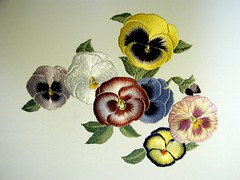
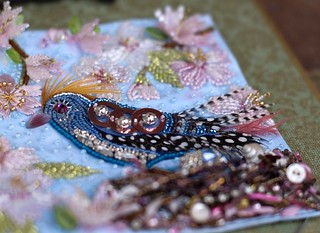
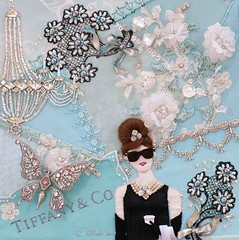
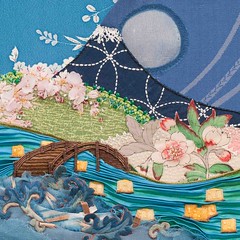
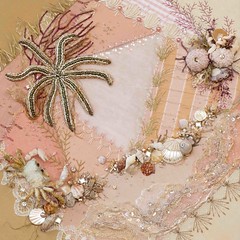


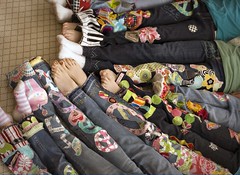









15 comments:
Such excellent tips. It is always nice to take a class and then use that knowledge and enhance a project based on your own comfort zone. Your lettering on Tiffany is superb. Happy testing...
Always interesting to get the chance to experiment and explore. and having someone else's notes for guidance will be very helpful!
I have printed on my own fabric before, but I was unaware it would wash out. This is great to know. I too have had trouble with the rollers streaking ink down the fabric. So I will add a clean up sheet to my list of steps.
I have good luck with moving the fabric down on the freezer paper a bit and running a strip of transparent tape along the leading edge of the fabric. Allow about an inch of freezer paper to show above the adhered fabric and taped edge. The fabric stays in place and no troubles. (famous last words)
Deb
I've had mixed results with washing out inkjet ink from printed fabric designs--but I probably wasn't going as pale as I should have done. In my experiments (done several years ago) I found that I could not make up fabric/freezer paper pages in advance--I'm talking days in advance not hours. They'd separate with sitting and handling. I also would double check the leading edge before printing and if it seemed at all loose, I'd pull it up a bit and run a glue stick over the paper and then stick it back down.
I kinda like the distressed look of the ink on the fabric- may turn that into a design opportunity some day.... thanks for the tips. giving any thought to using this with you signature someday?
the silk sheer could be a top sheet over a fabric not easily printed on....i suppose you could even do the stitching before adding it to the other fabric...just thinkin'....
i have a picture 'pinned' for you over at "pinterest"....
at least it was trial run and a good one at that :) thanks for all the tips etc .. if I ever get round to having a go will pickle your brains ..lol :) love mouse xxxx
This is a great tip! I had no idea that you could wash it out! And I like the idea of using gray scale just in case it is not washable when finished.....thank you for such a great tip...
I was just reading another blog that talked about printing a picture to fabric. I guess this is going to be a process I'll be playing with in the future. Thanks for the tips.
Dear Susan,
These are fantastic tips. I've never been able to do lettering as I see it in my head, but then again, I've never tried freezer paper either. I'm going to add it to my grocery list. Hopefully they have it up here in Canada!
Hi Susan I will have to try the grayscale idea, sounds good. Usually I trim whatever fabric I am using so it is slightly smaller than the freezer paper leaving an edge to lead into the printer. I too have an old temperemental epson, so I have to try and fool it into thinking it has normal paper going through.It works most of the time (said very quietly so it won't hear).
I've printed on fabric & the first thing you should do it so pretreat it with this product
http://www.dharmatrading.com/html/eng/2883664-AA.shtml?lnav=transfers.html
It is Bubble Jet Set & Rinse. It will take the sizing out of the fabric & makes the fabric better prepared to take the ink. You ink will not wash out with this Jet Set when you use the special rinse. After my pieces come out of the rinse, then I lightly iron the fabric to further set the ink, then when dry, I use a light coat of clear acrylic spray. Hope that helps.
dot
Thanks for those tips. I have some designs that I want to teach and this is the perfect way to do the lettering.
Wonderful tips! I have a project in mind that this will come in handy! Thanks again!!
~Heather
I started using the gray scale technique a while back. I make mine very, very, light. I've used the backing from fabric that you can buy that is prepared for printing successfully instead of the freezer paper once the bought fabric was used. I also try to make my lines very thin so they are covered by the thread in case it doesn't wash out completely. My Bird's Eye View and Doodle Owl were both done this way.
Post a Comment